Comparative Analysis: Social Consciousness Theories and Perspectives
VerifiedAdded on 2022/10/17
|8
|1890
|249
Essay
AI Summary
This essay provides an in-depth review of social consciousness theories, focusing on the contributions of Paulo Freire, Lev Vygotsky, and Basil Bernstein. Freire's theory emphasizes the transformative power of education in shaping individuals and society, highlighting critical consciousness and the ability to challenge oppressive systems. Vygotsky's sociocultural theory underscores the importance of social interaction and cultural context in cognitive development, introducing concepts like the Zone of Proximal Development and the role of the More Knowledgeable Other. Bernstein's socio-linguistic perspective examines how language and social codes influence communication, social status, and individual development. The essay compares and contrasts these theories, highlighting their similarities and differences in relation to culture, language, education, and social change, while also discussing the interconnectedness of politics and education. The paper concludes by emphasizing the crucial role of social consciousness, supported by key elements such as education, in societal development.
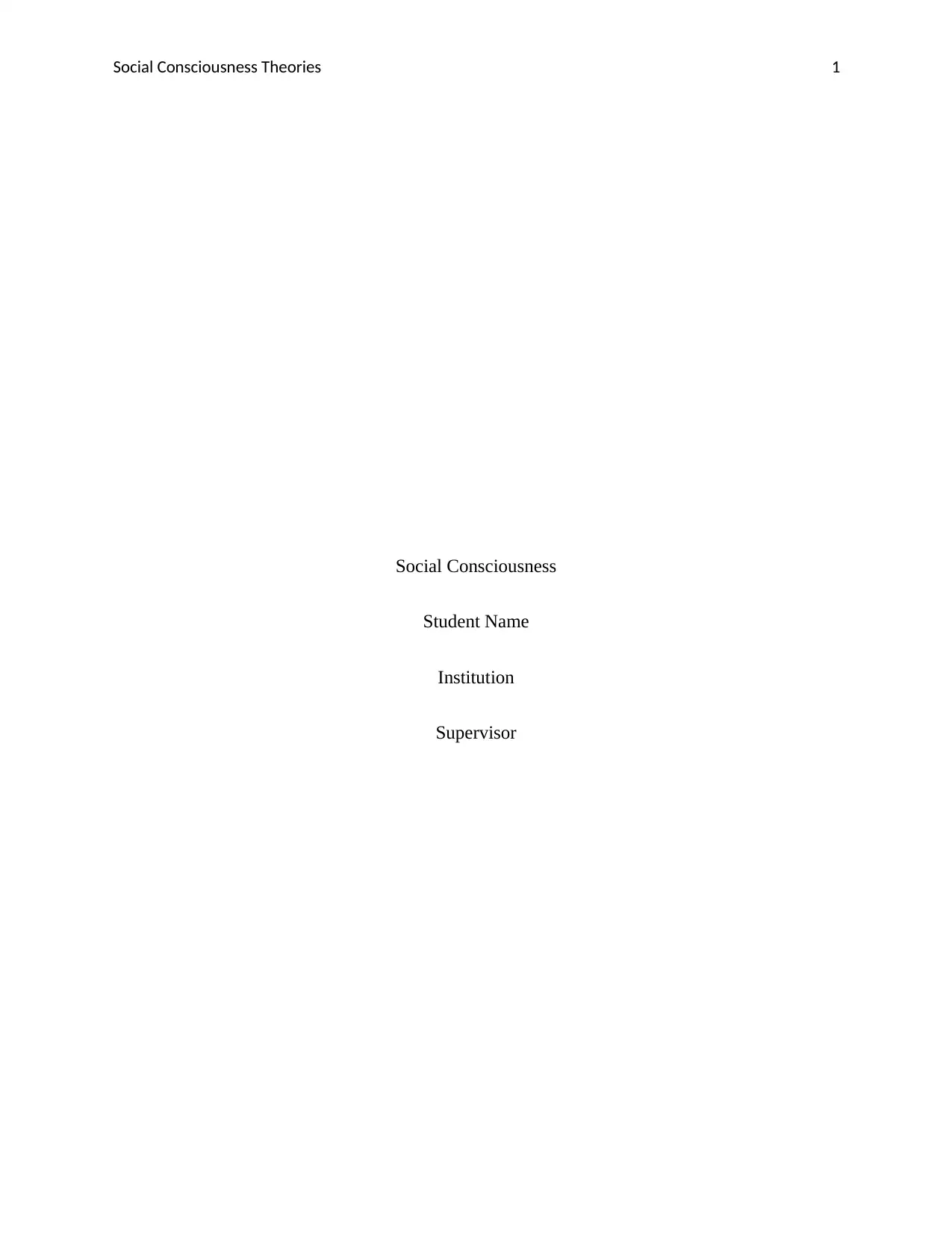
Social Consciousness Theories 1
Social Consciousness
Student Name
Institution
Supervisor
Social Consciousness
Student Name
Institution
Supervisor
Paraphrase This Document
Need a fresh take? Get an instant paraphrase of this document with our AI Paraphraser
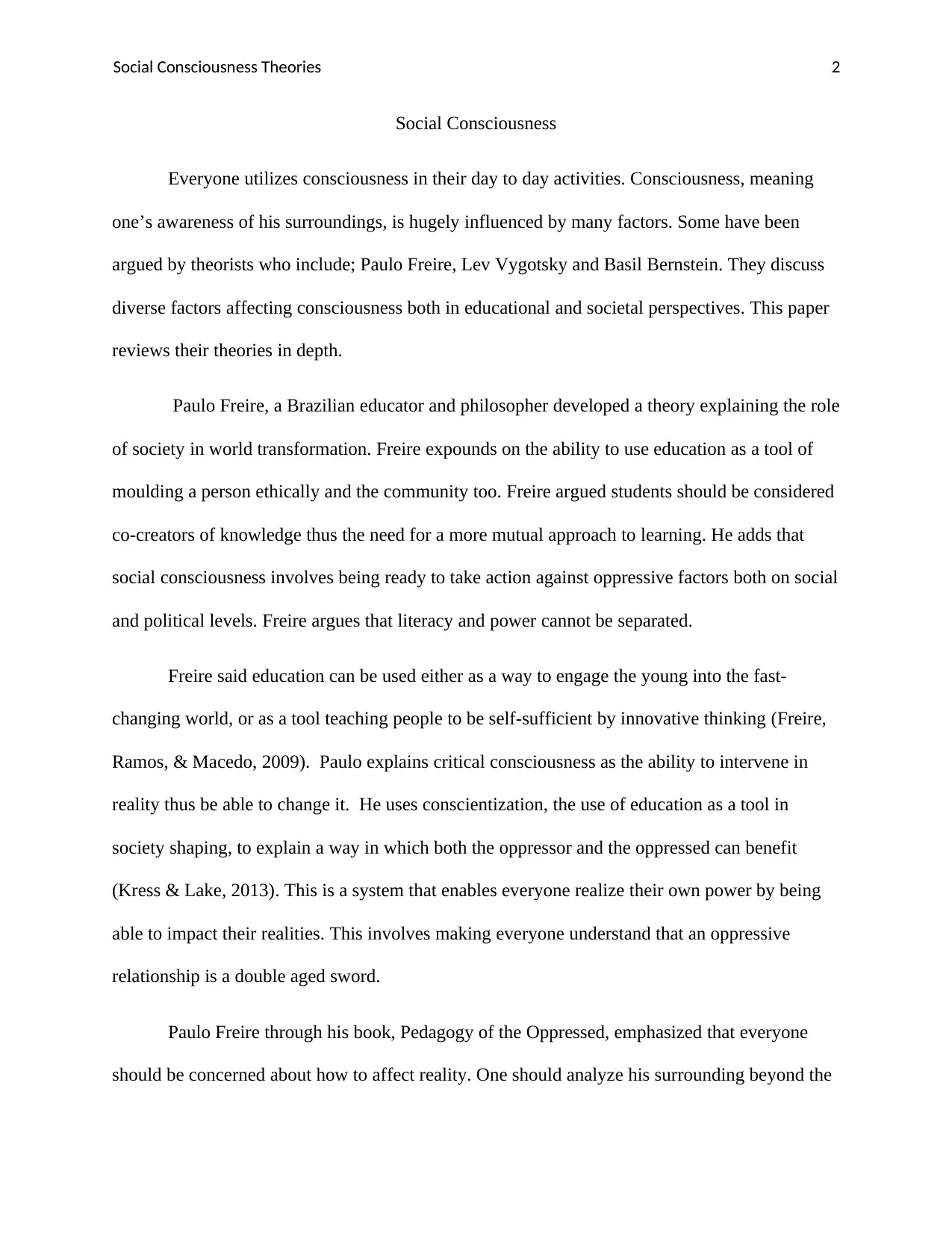
Social Consciousness Theories 2
Social Consciousness
Everyone utilizes consciousness in their day to day activities. Consciousness, meaning
one’s awareness of his surroundings, is hugely influenced by many factors. Some have been
argued by theorists who include; Paulo Freire, Lev Vygotsky and Basil Bernstein. They discuss
diverse factors affecting consciousness both in educational and societal perspectives. This paper
reviews their theories in depth.
Paulo Freire, a Brazilian educator and philosopher developed a theory explaining the role
of society in world transformation. Freire expounds on the ability to use education as a tool of
moulding a person ethically and the community too. Freire argued students should be considered
co-creators of knowledge thus the need for a more mutual approach to learning. He adds that
social consciousness involves being ready to take action against oppressive factors both on social
and political levels. Freire argues that literacy and power cannot be separated.
Freire said education can be used either as a way to engage the young into the fast-
changing world, or as a tool teaching people to be self-sufficient by innovative thinking (Freire,
Ramos, & Macedo, 2009). Paulo explains critical consciousness as the ability to intervene in
reality thus be able to change it. He uses conscientization, the use of education as a tool in
society shaping, to explain a way in which both the oppressor and the oppressed can benefit
(Kress & Lake, 2013). This is a system that enables everyone realize their own power by being
able to impact their realities. This involves making everyone understand that an oppressive
relationship is a double aged sword.
Paulo Freire through his book, Pedagogy of the Oppressed, emphasized that everyone
should be concerned about how to affect reality. One should analyze his surrounding beyond the
Social Consciousness
Everyone utilizes consciousness in their day to day activities. Consciousness, meaning
one’s awareness of his surroundings, is hugely influenced by many factors. Some have been
argued by theorists who include; Paulo Freire, Lev Vygotsky and Basil Bernstein. They discuss
diverse factors affecting consciousness both in educational and societal perspectives. This paper
reviews their theories in depth.
Paulo Freire, a Brazilian educator and philosopher developed a theory explaining the role
of society in world transformation. Freire expounds on the ability to use education as a tool of
moulding a person ethically and the community too. Freire argued students should be considered
co-creators of knowledge thus the need for a more mutual approach to learning. He adds that
social consciousness involves being ready to take action against oppressive factors both on social
and political levels. Freire argues that literacy and power cannot be separated.
Freire said education can be used either as a way to engage the young into the fast-
changing world, or as a tool teaching people to be self-sufficient by innovative thinking (Freire,
Ramos, & Macedo, 2009). Paulo explains critical consciousness as the ability to intervene in
reality thus be able to change it. He uses conscientization, the use of education as a tool in
society shaping, to explain a way in which both the oppressor and the oppressed can benefit
(Kress & Lake, 2013). This is a system that enables everyone realize their own power by being
able to impact their realities. This involves making everyone understand that an oppressive
relationship is a double aged sword.
Paulo Freire through his book, Pedagogy of the Oppressed, emphasized that everyone
should be concerned about how to affect reality. One should analyze his surrounding beyond the
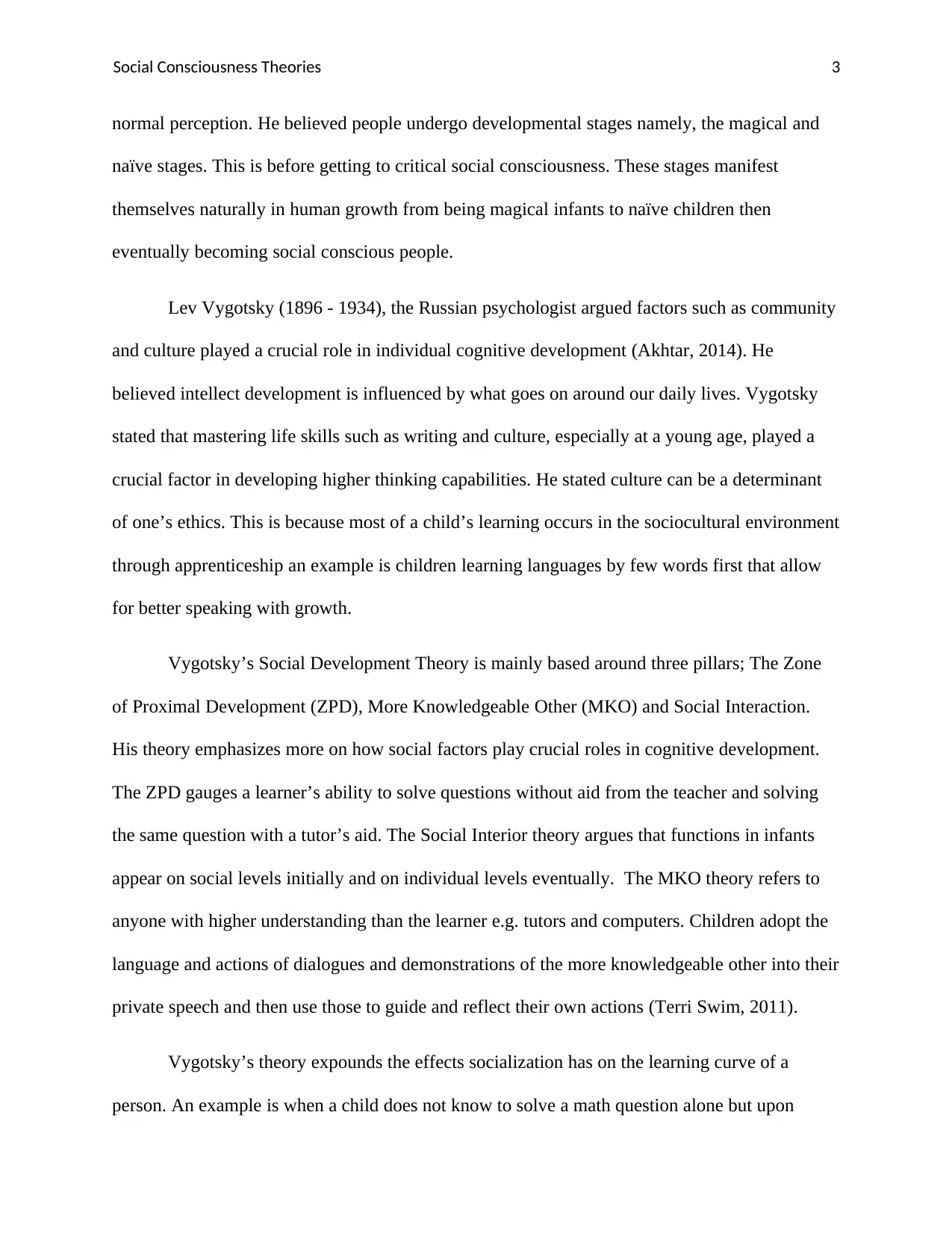
Social Consciousness Theories 3
normal perception. He believed people undergo developmental stages namely, the magical and
naïve stages. This is before getting to critical social consciousness. These stages manifest
themselves naturally in human growth from being magical infants to naïve children then
eventually becoming social conscious people.
Lev Vygotsky (1896 - 1934), the Russian psychologist argued factors such as community
and culture played a crucial role in individual cognitive development (Akhtar, 2014). He
believed intellect development is influenced by what goes on around our daily lives. Vygotsky
stated that mastering life skills such as writing and culture, especially at a young age, played a
crucial factor in developing higher thinking capabilities. He stated culture can be a determinant
of one’s ethics. This is because most of a child’s learning occurs in the sociocultural environment
through apprenticeship an example is children learning languages by few words first that allow
for better speaking with growth.
Vygotsky’s Social Development Theory is mainly based around three pillars; The Zone
of Proximal Development (ZPD), More Knowledgeable Other (MKO) and Social Interaction.
His theory emphasizes more on how social factors play crucial roles in cognitive development.
The ZPD gauges a learner’s ability to solve questions without aid from the teacher and solving
the same question with a tutor’s aid. The Social Interior theory argues that functions in infants
appear on social levels initially and on individual levels eventually. The MKO theory refers to
anyone with higher understanding than the learner e.g. tutors and computers. Children adopt the
language and actions of dialogues and demonstrations of the more knowledgeable other into their
private speech and then use those to guide and reflect their own actions (Terri Swim, 2011).
Vygotsky’s theory expounds the effects socialization has on the learning curve of a
person. An example is when a child does not know to solve a math question alone but upon
normal perception. He believed people undergo developmental stages namely, the magical and
naïve stages. This is before getting to critical social consciousness. These stages manifest
themselves naturally in human growth from being magical infants to naïve children then
eventually becoming social conscious people.
Lev Vygotsky (1896 - 1934), the Russian psychologist argued factors such as community
and culture played a crucial role in individual cognitive development (Akhtar, 2014). He
believed intellect development is influenced by what goes on around our daily lives. Vygotsky
stated that mastering life skills such as writing and culture, especially at a young age, played a
crucial factor in developing higher thinking capabilities. He stated culture can be a determinant
of one’s ethics. This is because most of a child’s learning occurs in the sociocultural environment
through apprenticeship an example is children learning languages by few words first that allow
for better speaking with growth.
Vygotsky’s Social Development Theory is mainly based around three pillars; The Zone
of Proximal Development (ZPD), More Knowledgeable Other (MKO) and Social Interaction.
His theory emphasizes more on how social factors play crucial roles in cognitive development.
The ZPD gauges a learner’s ability to solve questions without aid from the teacher and solving
the same question with a tutor’s aid. The Social Interior theory argues that functions in infants
appear on social levels initially and on individual levels eventually. The MKO theory refers to
anyone with higher understanding than the learner e.g. tutors and computers. Children adopt the
language and actions of dialogues and demonstrations of the more knowledgeable other into their
private speech and then use those to guide and reflect their own actions (Terri Swim, 2011).
Vygotsky’s theory expounds the effects socialization has on the learning curve of a
person. An example is when a child does not know to solve a math question alone but upon
⊘ This is a preview!⊘
Do you want full access?
Subscribe today to unlock all pages.

Trusted by 1+ million students worldwide
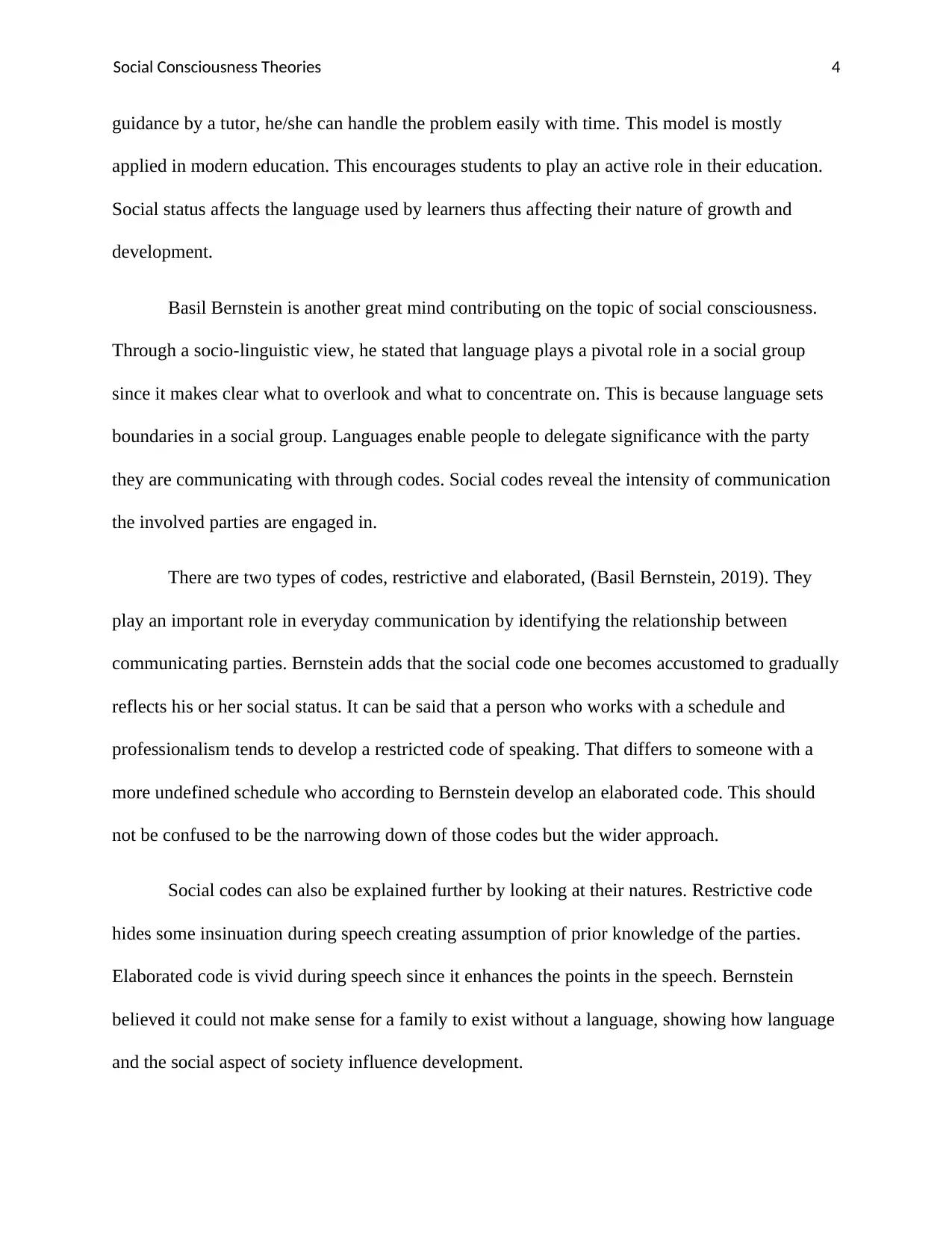
Social Consciousness Theories 4
guidance by a tutor, he/she can handle the problem easily with time. This model is mostly
applied in modern education. This encourages students to play an active role in their education.
Social status affects the language used by learners thus affecting their nature of growth and
development.
Basil Bernstein is another great mind contributing on the topic of social consciousness.
Through a socio-linguistic view, he stated that language plays a pivotal role in a social group
since it makes clear what to overlook and what to concentrate on. This is because language sets
boundaries in a social group. Languages enable people to delegate significance with the party
they are communicating with through codes. Social codes reveal the intensity of communication
the involved parties are engaged in.
There are two types of codes, restrictive and elaborated, (Basil Bernstein, 2019). They
play an important role in everyday communication by identifying the relationship between
communicating parties. Bernstein adds that the social code one becomes accustomed to gradually
reflects his or her social status. It can be said that a person who works with a schedule and
professionalism tends to develop a restricted code of speaking. That differs to someone with a
more undefined schedule who according to Bernstein develop an elaborated code. This should
not be confused to be the narrowing down of those codes but the wider approach.
Social codes can also be explained further by looking at their natures. Restrictive code
hides some insinuation during speech creating assumption of prior knowledge of the parties.
Elaborated code is vivid during speech since it enhances the points in the speech. Bernstein
believed it could not make sense for a family to exist without a language, showing how language
and the social aspect of society influence development.
guidance by a tutor, he/she can handle the problem easily with time. This model is mostly
applied in modern education. This encourages students to play an active role in their education.
Social status affects the language used by learners thus affecting their nature of growth and
development.
Basil Bernstein is another great mind contributing on the topic of social consciousness.
Through a socio-linguistic view, he stated that language plays a pivotal role in a social group
since it makes clear what to overlook and what to concentrate on. This is because language sets
boundaries in a social group. Languages enable people to delegate significance with the party
they are communicating with through codes. Social codes reveal the intensity of communication
the involved parties are engaged in.
There are two types of codes, restrictive and elaborated, (Basil Bernstein, 2019). They
play an important role in everyday communication by identifying the relationship between
communicating parties. Bernstein adds that the social code one becomes accustomed to gradually
reflects his or her social status. It can be said that a person who works with a schedule and
professionalism tends to develop a restricted code of speaking. That differs to someone with a
more undefined schedule who according to Bernstein develop an elaborated code. This should
not be confused to be the narrowing down of those codes but the wider approach.
Social codes can also be explained further by looking at their natures. Restrictive code
hides some insinuation during speech creating assumption of prior knowledge of the parties.
Elaborated code is vivid during speech since it enhances the points in the speech. Bernstein
believed it could not make sense for a family to exist without a language, showing how language
and the social aspect of society influence development.
Paraphrase This Document
Need a fresh take? Get an instant paraphrase of this document with our AI Paraphraser
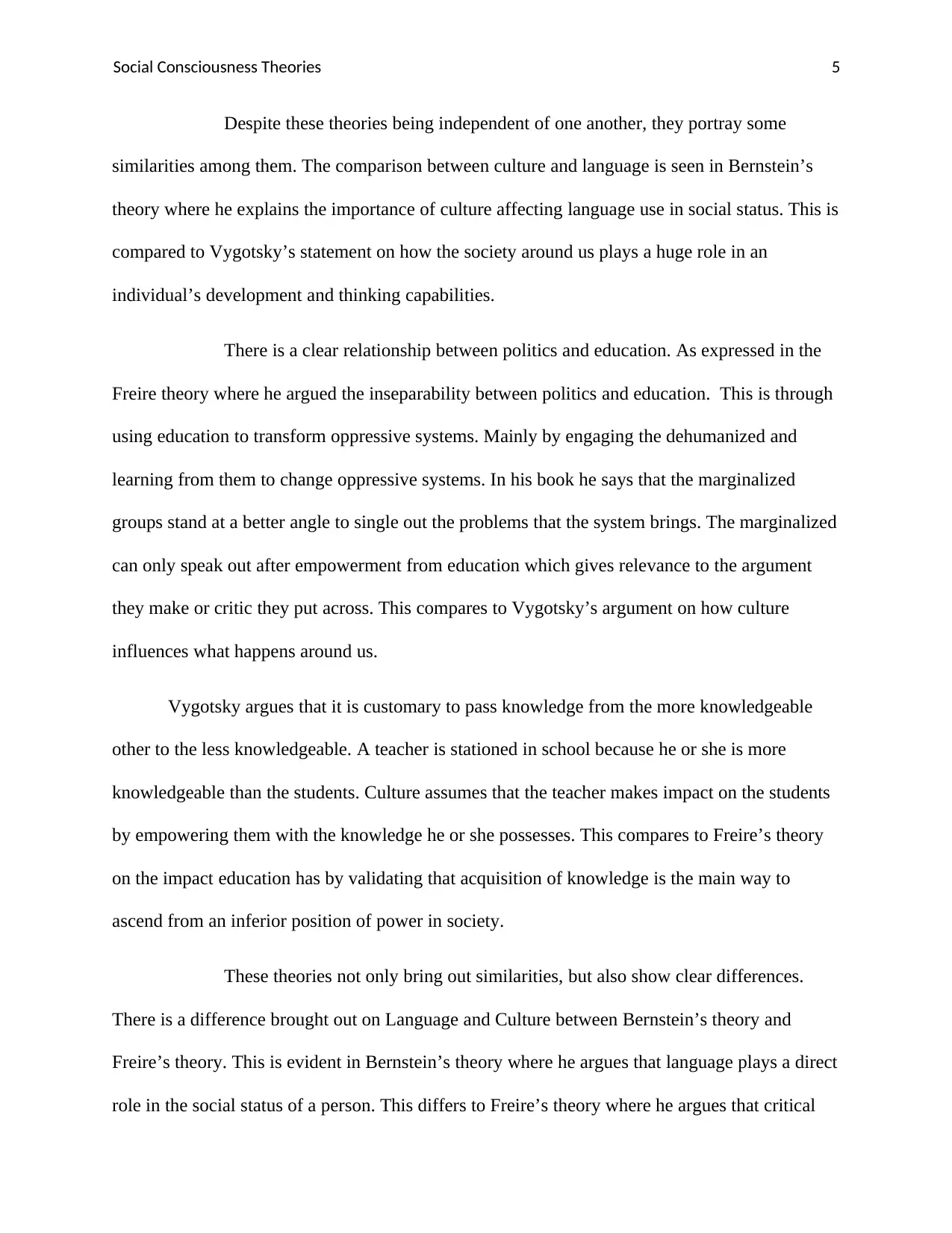
Social Consciousness Theories 5
Despite these theories being independent of one another, they portray some
similarities among them. The comparison between culture and language is seen in Bernstein’s
theory where he explains the importance of culture affecting language use in social status. This is
compared to Vygotsky’s statement on how the society around us plays a huge role in an
individual’s development and thinking capabilities.
There is a clear relationship between politics and education. As expressed in the
Freire theory where he argued the inseparability between politics and education. This is through
using education to transform oppressive systems. Mainly by engaging the dehumanized and
learning from them to change oppressive systems. In his book he says that the marginalized
groups stand at a better angle to single out the problems that the system brings. The marginalized
can only speak out after empowerment from education which gives relevance to the argument
they make or critic they put across. This compares to Vygotsky’s argument on how culture
influences what happens around us.
Vygotsky argues that it is customary to pass knowledge from the more knowledgeable
other to the less knowledgeable. A teacher is stationed in school because he or she is more
knowledgeable than the students. Culture assumes that the teacher makes impact on the students
by empowering them with the knowledge he or she possesses. This compares to Freire’s theory
on the impact education has by validating that acquisition of knowledge is the main way to
ascend from an inferior position of power in society.
These theories not only bring out similarities, but also show clear differences.
There is a difference brought out on Language and Culture between Bernstein’s theory and
Freire’s theory. This is evident in Bernstein’s theory where he argues that language plays a direct
role in the social status of a person. This differs to Freire’s theory where he argues that critical
Despite these theories being independent of one another, they portray some
similarities among them. The comparison between culture and language is seen in Bernstein’s
theory where he explains the importance of culture affecting language use in social status. This is
compared to Vygotsky’s statement on how the society around us plays a huge role in an
individual’s development and thinking capabilities.
There is a clear relationship between politics and education. As expressed in the
Freire theory where he argued the inseparability between politics and education. This is through
using education to transform oppressive systems. Mainly by engaging the dehumanized and
learning from them to change oppressive systems. In his book he says that the marginalized
groups stand at a better angle to single out the problems that the system brings. The marginalized
can only speak out after empowerment from education which gives relevance to the argument
they make or critic they put across. This compares to Vygotsky’s argument on how culture
influences what happens around us.
Vygotsky argues that it is customary to pass knowledge from the more knowledgeable
other to the less knowledgeable. A teacher is stationed in school because he or she is more
knowledgeable than the students. Culture assumes that the teacher makes impact on the students
by empowering them with the knowledge he or she possesses. This compares to Freire’s theory
on the impact education has by validating that acquisition of knowledge is the main way to
ascend from an inferior position of power in society.
These theories not only bring out similarities, but also show clear differences.
There is a difference brought out on Language and Culture between Bernstein’s theory and
Freire’s theory. This is evident in Bernstein’s theory where he argues that language plays a direct
role in the social status of a person. This differs to Freire’s theory where he argues that critical
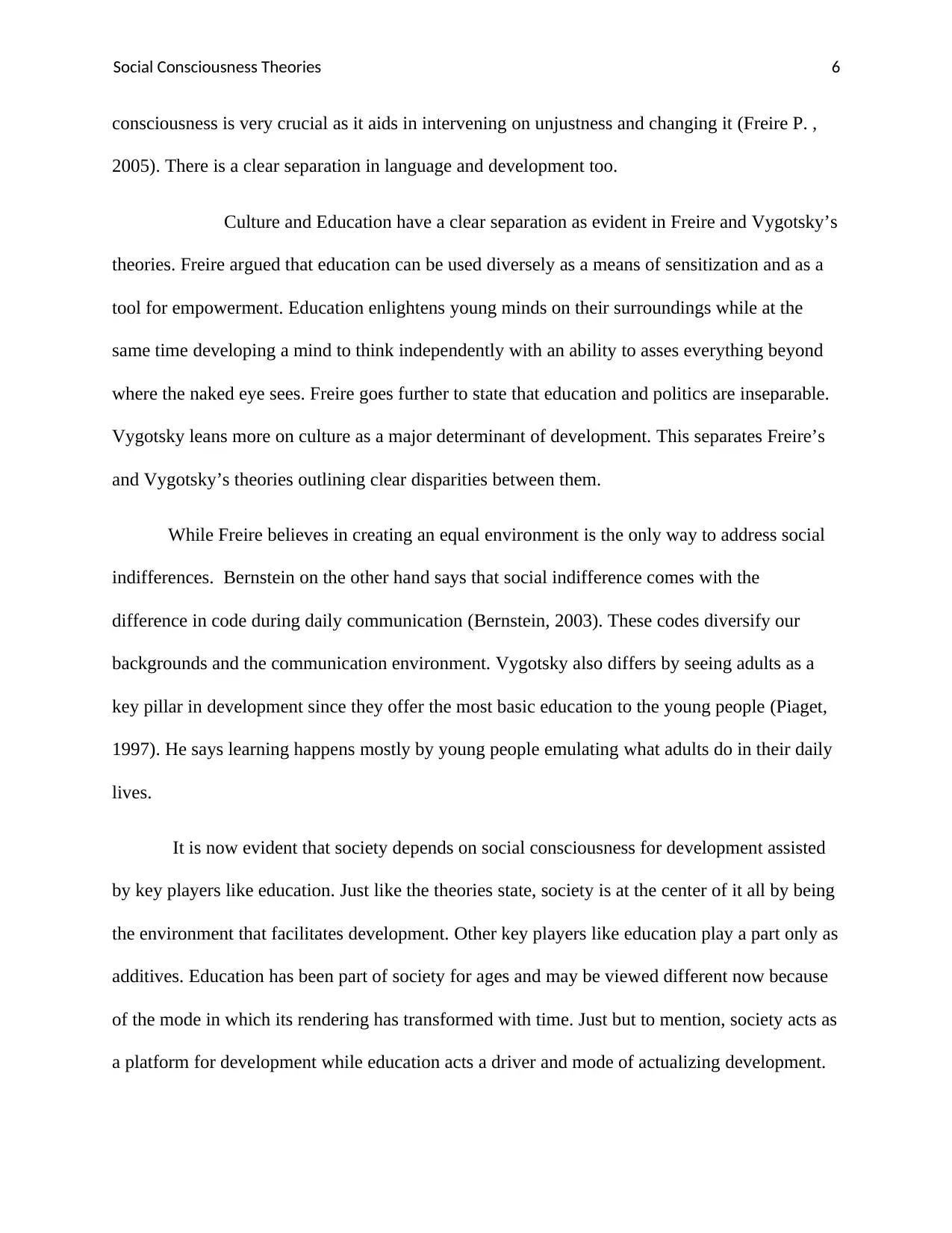
Social Consciousness Theories 6
consciousness is very crucial as it aids in intervening on unjustness and changing it (Freire P. ,
2005). There is a clear separation in language and development too.
Culture and Education have a clear separation as evident in Freire and Vygotsky’s
theories. Freire argued that education can be used diversely as a means of sensitization and as a
tool for empowerment. Education enlightens young minds on their surroundings while at the
same time developing a mind to think independently with an ability to asses everything beyond
where the naked eye sees. Freire goes further to state that education and politics are inseparable.
Vygotsky leans more on culture as a major determinant of development. This separates Freire’s
and Vygotsky’s theories outlining clear disparities between them.
While Freire believes in creating an equal environment is the only way to address social
indifferences. Bernstein on the other hand says that social indifference comes with the
difference in code during daily communication (Bernstein, 2003). These codes diversify our
backgrounds and the communication environment. Vygotsky also differs by seeing adults as a
key pillar in development since they offer the most basic education to the young people (Piaget,
1997). He says learning happens mostly by young people emulating what adults do in their daily
lives.
It is now evident that society depends on social consciousness for development assisted
by key players like education. Just like the theories state, society is at the center of it all by being
the environment that facilitates development. Other key players like education play a part only as
additives. Education has been part of society for ages and may be viewed different now because
of the mode in which its rendering has transformed with time. Just but to mention, society acts as
a platform for development while education acts a driver and mode of actualizing development.
consciousness is very crucial as it aids in intervening on unjustness and changing it (Freire P. ,
2005). There is a clear separation in language and development too.
Culture and Education have a clear separation as evident in Freire and Vygotsky’s
theories. Freire argued that education can be used diversely as a means of sensitization and as a
tool for empowerment. Education enlightens young minds on their surroundings while at the
same time developing a mind to think independently with an ability to asses everything beyond
where the naked eye sees. Freire goes further to state that education and politics are inseparable.
Vygotsky leans more on culture as a major determinant of development. This separates Freire’s
and Vygotsky’s theories outlining clear disparities between them.
While Freire believes in creating an equal environment is the only way to address social
indifferences. Bernstein on the other hand says that social indifference comes with the
difference in code during daily communication (Bernstein, 2003). These codes diversify our
backgrounds and the communication environment. Vygotsky also differs by seeing adults as a
key pillar in development since they offer the most basic education to the young people (Piaget,
1997). He says learning happens mostly by young people emulating what adults do in their daily
lives.
It is now evident that society depends on social consciousness for development assisted
by key players like education. Just like the theories state, society is at the center of it all by being
the environment that facilitates development. Other key players like education play a part only as
additives. Education has been part of society for ages and may be viewed different now because
of the mode in which its rendering has transformed with time. Just but to mention, society acts as
a platform for development while education acts a driver and mode of actualizing development.
⊘ This is a preview!⊘
Do you want full access?
Subscribe today to unlock all pages.

Trusted by 1+ million students worldwide
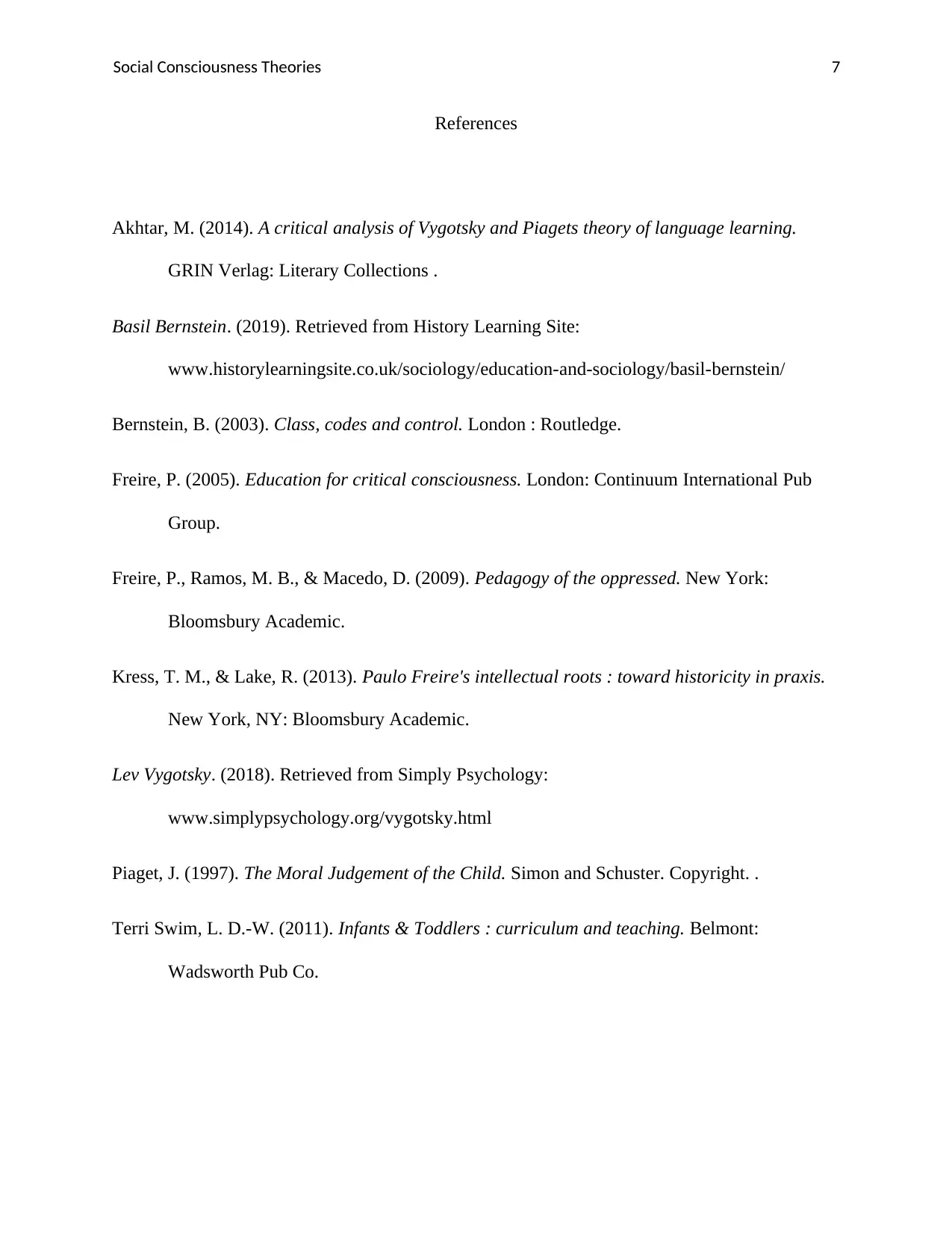
Social Consciousness Theories 7
References
Akhtar, M. (2014). A critical analysis of Vygotsky and Piagets theory of language learning.
GRIN Verlag: Literary Collections .
Basil Bernstein. (2019). Retrieved from History Learning Site:
www.historylearningsite.co.uk/sociology/education-and-sociology/basil-bernstein/
Bernstein, B. (2003). Class, codes and control. London : Routledge.
Freire, P. (2005). Education for critical consciousness. London: Continuum International Pub
Group.
Freire, P., Ramos, M. B., & Macedo, D. (2009). Pedagogy of the oppressed. New York:
Bloomsbury Academic.
Kress, T. M., & Lake, R. (2013). Paulo Freire's intellectual roots : toward historicity in praxis.
New York, NY: Bloomsbury Academic.
Lev Vygotsky. (2018). Retrieved from Simply Psychology:
www.simplypsychology.org/vygotsky.html
Piaget, J. (1997). The Moral Judgement of the Child. Simon and Schuster. Copyright. .
Terri Swim, L. D.-W. (2011). Infants & Toddlers : curriculum and teaching. Belmont:
Wadsworth Pub Co.
References
Akhtar, M. (2014). A critical analysis of Vygotsky and Piagets theory of language learning.
GRIN Verlag: Literary Collections .
Basil Bernstein. (2019). Retrieved from History Learning Site:
www.historylearningsite.co.uk/sociology/education-and-sociology/basil-bernstein/
Bernstein, B. (2003). Class, codes and control. London : Routledge.
Freire, P. (2005). Education for critical consciousness. London: Continuum International Pub
Group.
Freire, P., Ramos, M. B., & Macedo, D. (2009). Pedagogy of the oppressed. New York:
Bloomsbury Academic.
Kress, T. M., & Lake, R. (2013). Paulo Freire's intellectual roots : toward historicity in praxis.
New York, NY: Bloomsbury Academic.
Lev Vygotsky. (2018). Retrieved from Simply Psychology:
www.simplypsychology.org/vygotsky.html
Piaget, J. (1997). The Moral Judgement of the Child. Simon and Schuster. Copyright. .
Terri Swim, L. D.-W. (2011). Infants & Toddlers : curriculum and teaching. Belmont:
Wadsworth Pub Co.
Paraphrase This Document
Need a fresh take? Get an instant paraphrase of this document with our AI Paraphraser
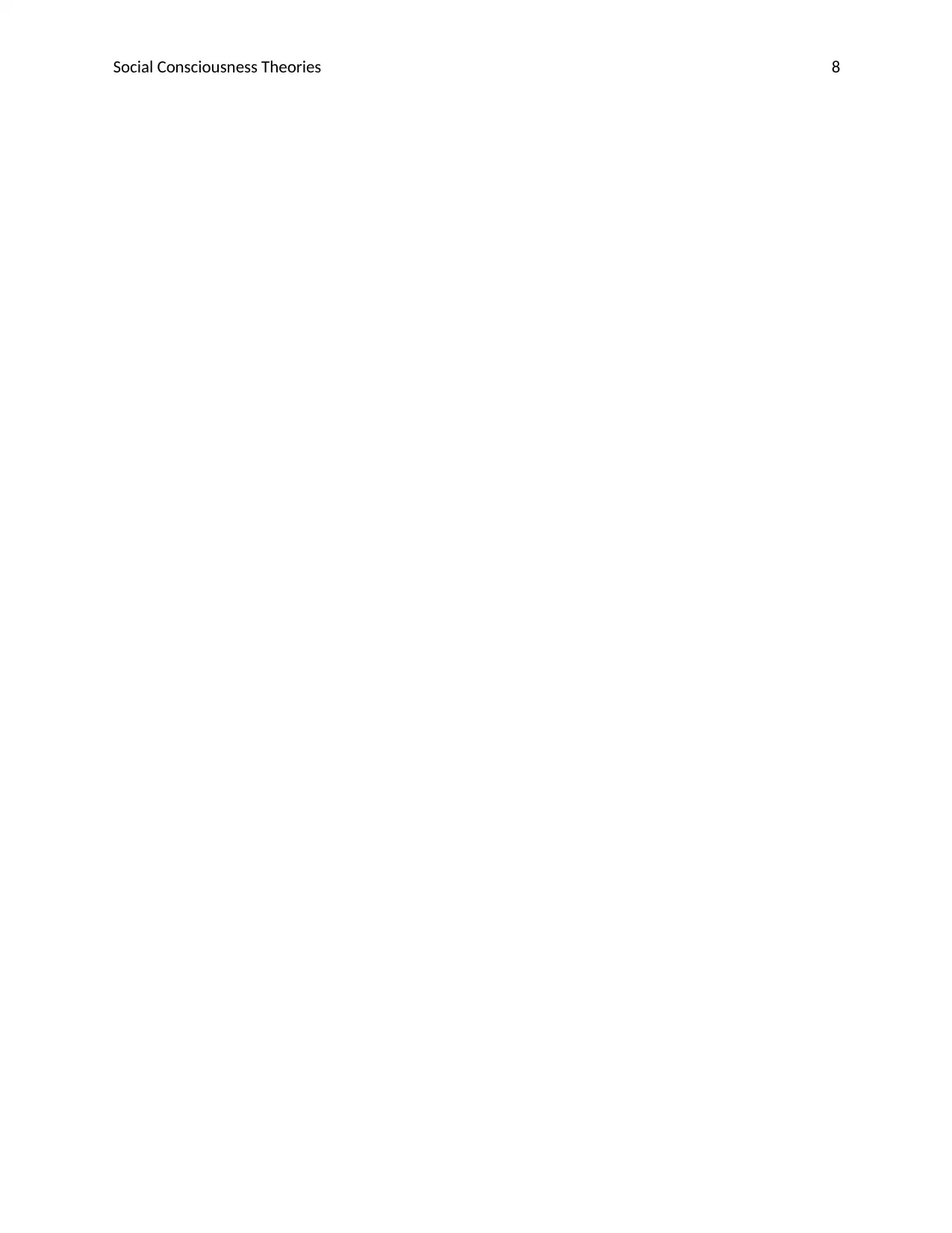
Social Consciousness Theories 8
1 out of 8
Related Documents
Your All-in-One AI-Powered Toolkit for Academic Success.
+13062052269
info@desklib.com
Available 24*7 on WhatsApp / Email
![[object Object]](/_next/static/media/star-bottom.7253800d.svg)
Unlock your academic potential
Copyright © 2020–2025 A2Z Services. All Rights Reserved. Developed and managed by ZUCOL.





